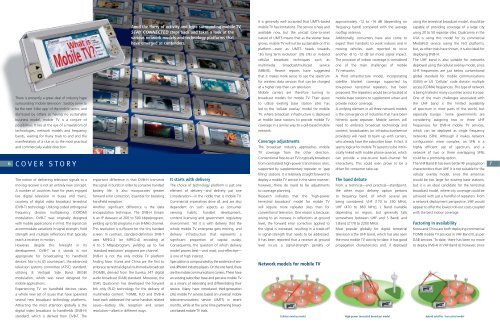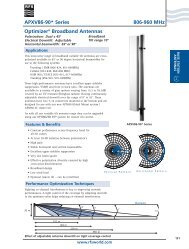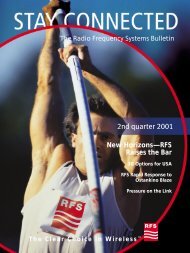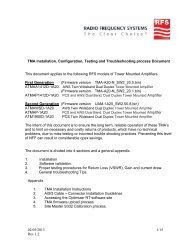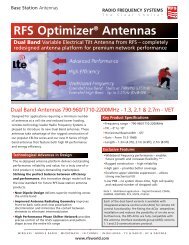Download - Radio Frequency Systems
Download - Radio Frequency Systems
Download - Radio Frequency Systems
You also want an ePaper? Increase the reach of your titles
YUMPU automatically turns print PDFs into web optimized ePapers that Google loves.
Amid the flurry of activity and hype surrounding mobile TV,<br />
STAY CONNECTED steps back and takes a look at the<br />
various network models and technology platforms that<br />
have emerged as contenders.<br />
It is generally well accepted that UMTS-based<br />
mobile TV has limitations. The service is here and<br />
available now, but the unicast (one-to-one)<br />
nature of UMTS means that as the viewer base<br />
grows, mobile TV will not be sustainable on this<br />
approximately -12 to -16 dB (depending on<br />
frequency band) compared with the average<br />
rooftop antenna.<br />
Additionally, consumers have also come to<br />
expect their handsets to work indoors and in<br />
using the terrestrial broadcast model, should be<br />
capable of providing coverage of a large city<br />
using 20 to 50 repeater sites. Qualcomm in the<br />
USA is using this model for its commercial<br />
MediaFLO service (using the FLO platform),<br />
platform—even as UMTS heads towards<br />
moving vehicles, each reported to incur<br />
but, as other trials have shown, it is also ideal for<br />
‘3G long term evolution’ (3G LTE) or in-band<br />
another -8 to -12 dB (or more) signal impact.<br />
deploying DVB-H.<br />
cellular broadcast techniques such as<br />
The provision of indoor coverage is considered<br />
The UHF band is also suitable for networks<br />
multimedia broadcast/multicast service<br />
one of the main challenges of mobile<br />
deployed using the cellular overlay model, since<br />
(MBMS). Recent reports have suggested<br />
TV networks.<br />
UHF frequencies are just below conventional<br />
that it makes more sense to use the spectrum<br />
A third infrastructure model, incorporating<br />
global standard for mobile communications<br />
for wireless data services that can be charged<br />
satellite blanket coverage supported by<br />
(GSM) or US ‘Cellular’ code division multiple<br />
at a higher rate than can television.<br />
low-power terrestrial repeaters, has been<br />
access (CDMA) frequencies. This type of network<br />
Mobile carriers are therefore turning to<br />
proposed. The repeaters would be co-located at<br />
is being trialed in many countries across Europe.<br />
There is presently a great deal of industry hype<br />
broadcast models for mobile TV. Their quest<br />
mobile base stations to supplement urban and<br />
One of the main challenges associated with<br />
surrounding ‘mobile television’. Said by some to<br />
to utilize existing base station sites has<br />
provide indoor coverage.<br />
the UHF band is the limited availability<br />
be the next ‘killer app’ of the mobile sector, and<br />
led to the ‘cellular overlay’ model for mobile<br />
A unifying element in all three network models<br />
of spectrum in most parts of the world, but<br />
dismissed by others as having no sustainable<br />
TV, where broadcast infrastructure is deployed<br />
is the convergence of industries that have been<br />
especially Europe. Some governments are<br />
business model, mobile TV is a conjure of<br />
at mobile base stations to provide mobile TV<br />
hitherto quite separate. Mobile carriers will<br />
considering assigning two or three UHF<br />
possibilities. It lies at the eye of a maelstrom of<br />
coverage in a similar way to a cell-based mobile<br />
need to embrace broadcast technology and<br />
frequencies for DVB-H mobile TV services,<br />
technologies, network models and frequency<br />
network.<br />
content; broadcasters (or infrastructure/service<br />
which can be deployed as single frequency<br />
bands, waiting for many trials to end and the<br />
manifestation of a clue as to the most practical<br />
Coverage adjustments<br />
providers) will need to team up with carriers,<br />
who already have the subscriber base. In fact, it<br />
networks (SFN). Although it makes network<br />
configuration more complex, an SFN is a<br />
and commercially viable direction.<br />
The broadcast industry approaches mobile<br />
seems logical for mobile TV systems to be intrin-<br />
highly efficient use of spectrum, and a<br />
TV coverage from the other direction.<br />
sically linked with mobile phone services, which<br />
network of two or three overlapping SFNs<br />
6 COVER STORY<br />
Conventional free-to-air TV is typically broadcast<br />
from centralized high-power transmission sites,<br />
supported by supplementary repeater or ‘gap<br />
can provide a one-to-one back-channel for<br />
interactivity. This could even prove to be a<br />
driver for consumer take-up.<br />
could be a promising option.<br />
The VHF Band III has even better RF propagation<br />
characteristics than UHF. It is not suitable for the<br />
7<br />
The notion of delivering television signals to a<br />
important difference is that DVB-H transmits<br />
It starts with delivery<br />
filling’ stations. It is relatively straightforward to<br />
deploy a mobile TV service in the same manner;<br />
The band debate<br />
cellular overlay model, since the antennas<br />
would be too large for existing base stations;<br />
moving receiver is not an entirely new concept.<br />
the signal in bursts in order to conserve handset<br />
The choice of technology platform is just one<br />
however, there do need to be adjustments<br />
From a technical—and practical—standpoint,<br />
but it is an ideal candidate for the terrestrial<br />
A number of countries have for years enjoyed<br />
battery life. It also incorporates greater<br />
element of delivery—and delivery just one<br />
to coverage planning.<br />
the other major delivery option pertains<br />
broadcast model, where city coverage could be<br />
live digital television in buses and trains,<br />
forward error correction, essential for boosting<br />
consideration—in the riddle that is mobile TV.<br />
Research indicates that the ‘high-power<br />
to frequency band, of which several are<br />
achieved with just a handful of repeaters. From<br />
courtesy of digital video broadcast terrestrial<br />
handheld reception.<br />
Commercial imperatives drive all, and are also<br />
terrestrial broadcast’ model for mobile TV<br />
being considered: VHF (170 to 240 MHz),<br />
a network deployment perspective, VHF would<br />
(DVB-T) technology. Utilizing coded orthogonal<br />
Another significant difference is the data<br />
dependent on such aspects as consumer<br />
will require more repeater sites than for<br />
UHF (470 to 860 MHz), L Band (variable<br />
appear to offer the lowest roll-out costs coupled<br />
frequency division multiplexing (COFDM)<br />
encapsulation technique. The DVB-H stream<br />
viewing habits, handset development,<br />
conventional television. One reason is because,<br />
depending on region, but generally falls<br />
with the best indoor coverage.<br />
modulation, DVB-T was originally designed<br />
with mobile applications in mind. The signal can<br />
is an IP datacast at 200 to 500 kbps/program,<br />
yielding up to 50 programs in an 8-MHz channel.<br />
content licensing and government regulatory<br />
environment. Yet it is with delivery that the<br />
owing to an increase in reflections at ground<br />
level, the forward error correction applied to<br />
somewhere between UHF and S Band) and<br />
S Band (2170 to 2200 MHz).<br />
Factoring in availability<br />
accommodate variations in signal strength, field<br />
This resolution is sufficient for the tiny handset<br />
whole mobile TV enterprise gets moving, and<br />
the signal is increased, resulting in a trade-off<br />
Most popular globally for digital terrestrial<br />
Korea and China are both deploying commercial<br />
strength and multiple reflections that typically<br />
screen. In contrast, standard-definition DVB-T<br />
delivery infrastructure that represents a<br />
in signal-strength that needs to be addressed.<br />
television is the UHF band, which has also seen<br />
T-DMB mobile TV services in VHF Band III, as per<br />
reach a receiver in motion.<br />
uses MPEG-2 (or MPEG-4) encoding at<br />
significant proportion of capital outlay.<br />
It has been reported that a receiver at ground<br />
the most mobile TV activity to-date. It has good<br />
DAB services. To-date, there has been no move<br />
However, despite this foresight in its<br />
4 to 5 Mbps/program, yielding up to five<br />
Consequently, the question of which delivery<br />
level incurs a signal-strength penalty of<br />
propagation characteristics and, if deployed<br />
to deploy DVB-H in VHF Band III; however, since<br />
development, DVB-T as it stands is not<br />
‘standard resolution’ programs per channel.<br />
model proves best—and most cost-effective—<br />
appropriate for broadcasting to handheld<br />
DVB-H is not the only mobile TV platform<br />
is one of high interest.<br />
devices. Nor is its US counterpart, the advanced<br />
television systems committee (ATSC) standard,<br />
finding favor. Korea and China are the first to<br />
embrace terrestrial digital multimedia broadcast<br />
Speculation is compounded by the existence of several<br />
different industry players. On the one hand, there<br />
Network models for mobile TV<br />
utilizing 8 Vestigial Side Band (8VSB)<br />
(T-DMB), derived from the Eureka 147 digital<br />
are the mobile communications carriers. These have<br />
modulation, which was never designed for<br />
audio broadcast (DAB) standard. Moreover, the<br />
an existing subscriber base and perceive mobile TV<br />
mobile applications.<br />
USA’s Qualcomm has developed the forward<br />
as a means of extending and differentiating their<br />
Experiencing TV on handheld devices raises<br />
link only (FLO) technology for the delivery of<br />
service. Many have introduced third-generation<br />
a whole new set of issues that have spawned<br />
multimedia content. T-DMB, FLO and DVB-H<br />
(3G) mobile TV services based on universal mobile<br />
several new broadcast technology platforms.<br />
have each addressed the same handset-related<br />
telecommunications service (UMTS) in recent<br />
Attracting the most attention globally is the<br />
issues—battery life, reception and screen<br />
months, while at the same time partnering broad-<br />
digital video broadcast to handhelds (DVB-H)<br />
resolution—albeit in different ways.<br />
cast-based mobile TV trials.<br />
standard, which is derived from DVB-T. The<br />
Cellular overlay model High-power terrestrial broadcast model Hybrid satellite / terrestrial model


